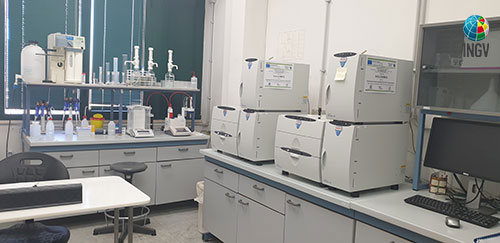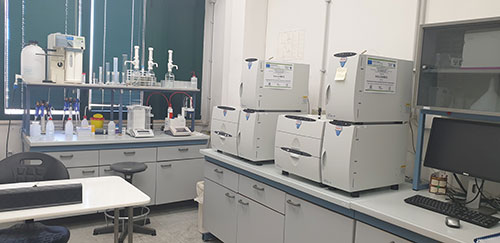The Ion Chromatography Laboratory of the Palermo Section of INGV began its activity towards the end of the 80s. The Lab analyzes samples of underground, thermal or marine waters, but also of fumarolic fluids emitted by volcanoes, to support the geochemical surveillance activities of volcanic areas and seismically active areas, as well as numerous research projects. Furthermore, analyzes are carried out for environmental investigations, for the study of geothermal fields and for hydrogeological studies.
To get a very simple idea, among the many analytical skills of the Laboratory there is also that of carrying out the chemical-physical analyzes that we read on the labels of bottles of mineral water.
We interviewed Sergio Bellomo, a researcher at INGV and head of the Lab who, together with Vincenzo Prano, works within it, to better explain the dynamics at the basis of their activity.
 Sergio, when was the Ion Chromatography Laboratory established and why?
Sergio, when was the Ion Chromatography Laboratory established and why?
About forty years ago, within the Institute of Fluid Geochemistry of the CNR, which then merged, in 1999, into the INGV as we know it today. Our Lab's objective was to develop and apply analytical methods for the quantitative determination of inorganic species dissolved in water samples. In the past, in chemistry laboratories, each single analytical species was determined with a specific method (with ion-selective electrodes, gravimetric methods or titrations), which was often very laborious and involved large quantities of sample.
The novelty of ion chromatography consists in the fact that it allows to determine all the major and minor anionic species (with the exception of the carbonate species) in a few minutes without any need to treat the sample, on very small quantities (a few millilitres) and with a only instrumentation. This represented a real revolution for researchers, the so-called "lab rats".
What has changed since then?
Ion chromatography methods immediately proved to be very precise and accurate and currently constitute a routine technique in all laboratories that deal with the analysis of water samples.
Continuous technological development has made it possible to have ever more performing and reliable instruments, with simple, precise, accurate analytical methodologies and with low running costs. Just think that one “chromatographic run” for anionic species (curious term, but which gives an idea of the speed of analysis) it takes only 15 minutes and allows you to simultaneously determine the concentrations of Fluorine, Chlorine, Nitrite, Bromine, Nitrate, Phosphate and Sulphate ions dissolved in one of the aqueous solutions.
What exactly is the ion chromatography method?
It is a technique based on the separation of the analytes, using an ion exchange column, based on their affinity for the stationary phase. Individual analytes then exit the column with different retention times. The eluent, containing the analytes, then passes through a post-column electrochemical device called suppressor which, by generating H+ ions by electrolysis, neutralizes the eluent and lowers its background conductivity, allowing better resolution of the analyte signal, which is detected using an online conductivity meter.
The recognition of the analytes takes place by comparing the retention times of the sample peaks with those of a reference solution.
From the integration of the areas of the individual chromatographic peaks, the concentrations of the analytes are obtained, by comparison with calibration curves obtained by injecting, under the same experimental conditions adopted for the samples, solutions at known concentrations included in the analytical investigation field.
What are the main activities you carry out within the Lab?
On average, more than 1000 analyzes are carried out in the laboratory every year, divided into three main sectors:
- analytical support to the geochemical surveillance activities of volcanic activity and the study of seismogenic processes, and to the projects pertaining to the various research lines of both the Palermo Section and other Sections of the INGV;
- service activities for State bodies for the environmental control of waters, landfills and the environment in general;
- technological development of the Lab both in terms of upgrade of the instruments present, and the development of new analytical methodologies for the determination of new elements in complex matrices.
What instruments does the Laboratory have?
The lab is equipped with two Dionex ICS-1100 chromatographs, two Thermo Scientific Dionex ICS-5000+ chromatographs and a Mettler Toledo automatic titrator.
The instruments are in duplicate because each of them has been configured to analyze only the anion species (F-, Cl-, NO2-, Br-, NO3-, SO42-PO43-) or only the cationic species (Li+, Na+, NH4+ , K+, Mg2+, Ca2+) and on liquid matrices of different nature. The redundancy of the instruments also allows us to reduce downtime to a minimum.
The analysis time of each chromatographic run varies according to the instrumental configuration: in general, however, the times are always very short and range from 12 minutes for routine analyzes to 35 minutes for particular analytical procedures.
These analytical techniques are used to determine the chemical composition of the major elements of natural waters (groundwater, thermal, meteoric, marine), fumarolic fluids (sampled for example using the Giggenbach ampoule method) and acidic species emitted by volcanic plumes sampled with alkaline traps.
The automatic titrator, which is not based on the chromatographic technique, on the other hand, allows the determination of alkalinity and the main carbonate species (carbonate ion and bicarbonate ion) dissolved in aqueous solution.




